(A) The regulations herein shall apply and govern all signs located in the City of Goose Creek. This section establishes the standards for the design, location, and characteristics of signs that are permitted as principal or accessory uses. No sign is permitted in the city except in conformity with this section.
(B) Purpose.
(1) The purpose of this section is to promote the public health, safety, and welfare; and regulate the markets through a comprehensive system of reasonable, effective, consistent, content-neutral, and nondiscriminatory sign standards and design requirements. With these concepts in mind, this section is adopted for the following purposes:
(a) To protect property values, the local economy, and the quality of life by preserving and enhancing the appearance of the public realm which affects the image of the city;
(b) To promote the free flow of traffic and protect pedestrians and motorists from injury and property damage caused by, or which may be partially attributable to cluttered, distracting, and/or illegible signage;
(c) To promote the use of signs which are aesthetically pleasing, of appropriate scale, and integrated with the surrounding buildings and landscape, in order to meet the community's expressed desire for quality development;
(d) To promote and accomplish the goals, policies, and objectives of City Council;
(e) To balance public and private objectives by allowing adequate signage for business identification;
(f) To provide design standards which are consistent with other applicable ordinances and provisions; and
(g) To reduce the risk of property damage and personal injury from signs which are improperly constructed, improperly installed or poorly maintained.
(2) To achieve these purposes, it is the intent of this section:
(a) To provide reasonably uniform standards while allowing functional flexibility, encourage variety, and create an incentive to relate signage to basic principles of good design;
(b) To assure that public benefits derived from expenditures of public funds for the improvement and beautification of streets, and other public structures and spaces, are protected by exercising reasonable control over the character and design of sign structures which are near the rights-of-way; and
(c) To provide an improved visual environment for the citizens of, and visitors to, the city.
(C) Definitions. For the purpose of this section, the following definitions shall apply unless the context clearly indicates or requires a different meaning.
ABANDONED SIGN. A permanent principal use sign on property containing a building that has ceased operations. Permanent principal use signs on property shall be considered abandoned when the business activity at the property has ended for a period of six months.
ADVERTISING SIGN. Any sign, pictorial or otherwise, regardless of size or shape, which directs attention to a business, commodity, attraction, profession, service or entertainment conducted, sold, offered, manufactured, existing or provided at a location other than on the premise where the sign is located or to which it is affixed. Such signs are sometimes called "off-premise signs" or "non-point-of-sale signs", and include, but are not limited to those signs commonly referred to as outdoor advertising signs, billboards or poster boards.
ANIMATED SIGN. A sign with action, motion, sound, or changing colors which accomplishes such action, motion, sound, or changing colors with or without electrical energy. This includes signs with lights or other illuminating devices that blink, flash, fluctuate, or have a changing light intensity, brightness, or color. This definition does not include a "swinging sign" or "multiple message sign" as defined by this section.
AREA OF SIGN. The area within a continuous perimeter enclosing the limits of writing, representation, emblem, figure, or character together with any frame, other material, open space, or color forming an integral part of the display or used to differentiate such writing, representation, emblem, figure, or character from the background against which it is placed. For double-faced signs, only the largest display face shall be measured in computing the sign area, or only one face shall be measured in computing sign area if the display faces are the same size. The display of street address on a ground sign, wall, or window shall not be computed in determining the maximum allowable area of ground sign, wall, or window sign.
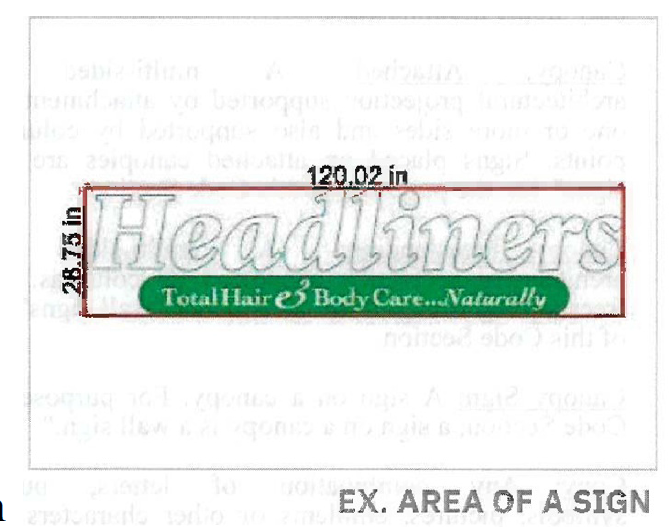
AWNING. An architectural projection or shelter projecting from and supported by the exterior wall of a building and composed of a covering of rigid or non-rigid materials and/or fabric on a supporting framework that may be either permanent or retractable.
AWNING SIGN. An awning that contains letters, numbers, symbols, pictures, logos, or visual display, or other communication, attached, painted on, or made an integral part of an awning. For purposes of this section, AWNING SIGNS shall be considered "wall signs."

BANDIT SIGN. A commercial sign posted on a utility pole, street sign, or other street furniture; or any other sign placed within a public right-of-way or public property. A BANDIT SIGN generally has less than six square feet or less of advertising area and is made of vinyl, paper, cloth or fabric, Polyboard™, corrugated plastic, poster board, plastic core, cardboard, wood, or plywood, including signs with wood or wire framing, posts, or stakes. All BANDIT SIGNS are prohibited and illegal.
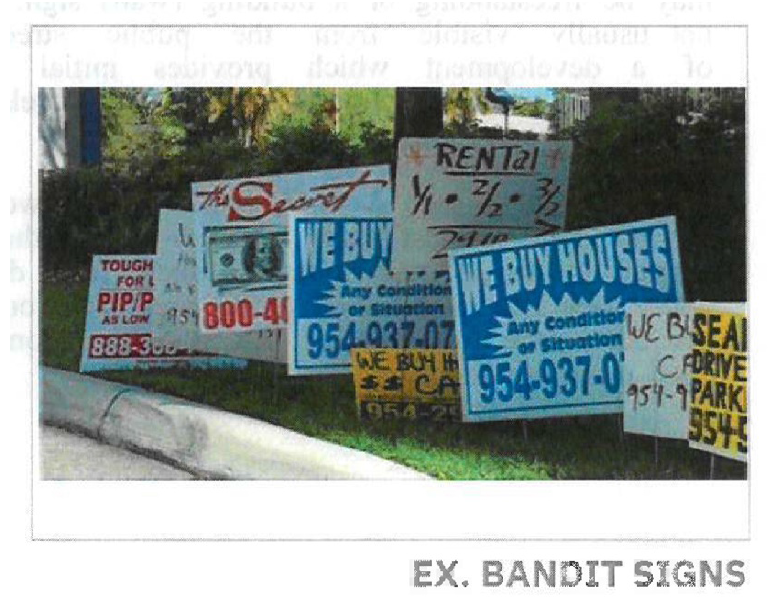
BANNER. A sign with or without characters, letters, illustrations, or ornamentation applied to cloth, paper, plastic, natural or synthetic fabric of any kind with only such material for a backing. For purposes of this section, a BANNER is a "sign."

BENCH SIGN. A sign with or without characters, letters, illustrations, or ornamentation applied to a bench for the purpose of advertising.
BUILDING MARKER. Any sign cut into a masonry surface or made of bronze or other permanent material.
BUILDING SIGN. A sign attached to a building, which may include wall signs, awning signs, and projecting signs.
BUSINESS FRONTAGE. The length of the face or wall of a completely enclosed permanent building frontage occupied by a building occupant and containing a main entrance.
CAN SIGN. A sign that contains all the text or text and logo symbols within a single enclosed cabinet which may or may not be illuminated.
CANOPY, ATTACHED. A multi-sided structure or architectural projection supported by attachment to a building on one or more sides and also supported by columns at additional points. Signs placed on attached canopies are considered "wall signs" for the purposes of this section.
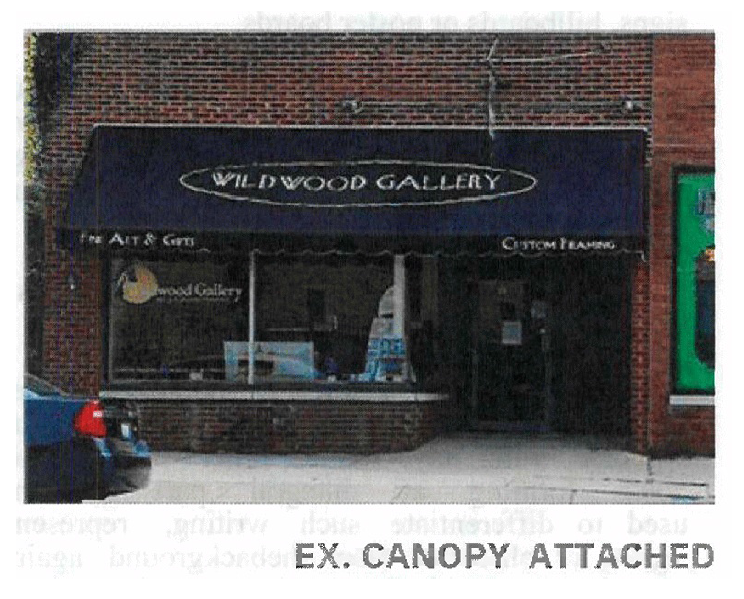
CANOPY, FREESTANDING. A multi-sided structure or architectural projection supported by columns. Signs placed on freestanding canopies are considered "wall signs" for the purposes of this section.
CANOPY SIGN. A sign on a canopy. For purposes of this section, a sign on a canopy is a "wall sign."
COPY. Any combination of letters, numerals, words, symbols, pictures, emblems or other characters that constitute a message.
DIRECTORY SIGN FOR MULTI-TENANT DEVELOPMENT. A sign, distinguished from a project entrance sign, which is allowed on a premise with more than one tenant or occupants of a building. It may be freestanding or a building (wall) sign. Such signs are not usually visible from the public street right-of-way of a development which provides initial access to the property, but rather are located within the development, along a driveway, access way, or parking aisle.
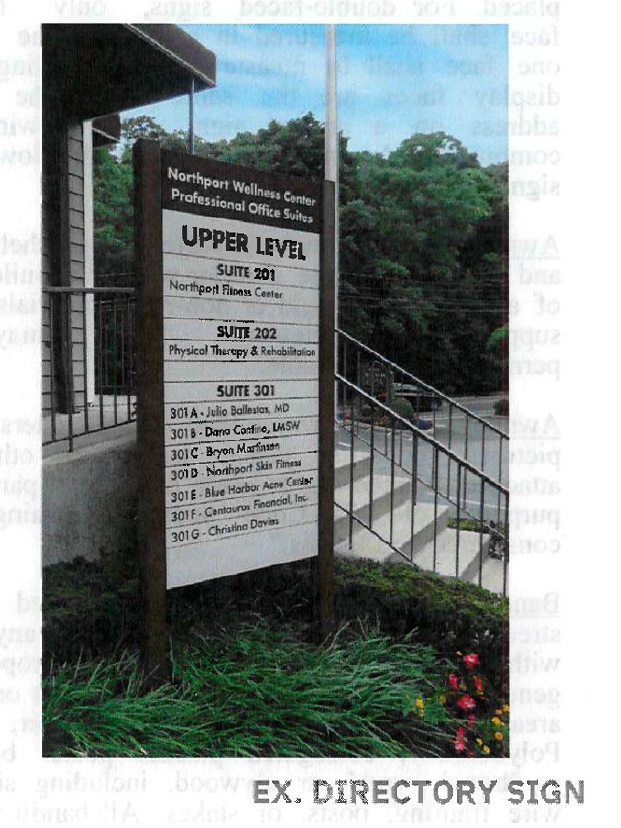
DOUBLE-FACED SIGN. A sign which has two identical display areas against each other or where the interior angle formed by the display areas is 60 degrees or less, where one face is designed to be seen from one direction and the other face from another direction. Only one face shall be used in computing allowable sign area.
ELECTRONIC MESSAGE BOARD (EMB). A permanent sign consisting of text, symbolic imagery, or both, that uses an electronic display created through use of a pattern of lights in a dot matrix allowing the sign face to intermittently change the image without having to physically or mechanically replace the sign face, including an LED (Light Emitting Diode) sign.
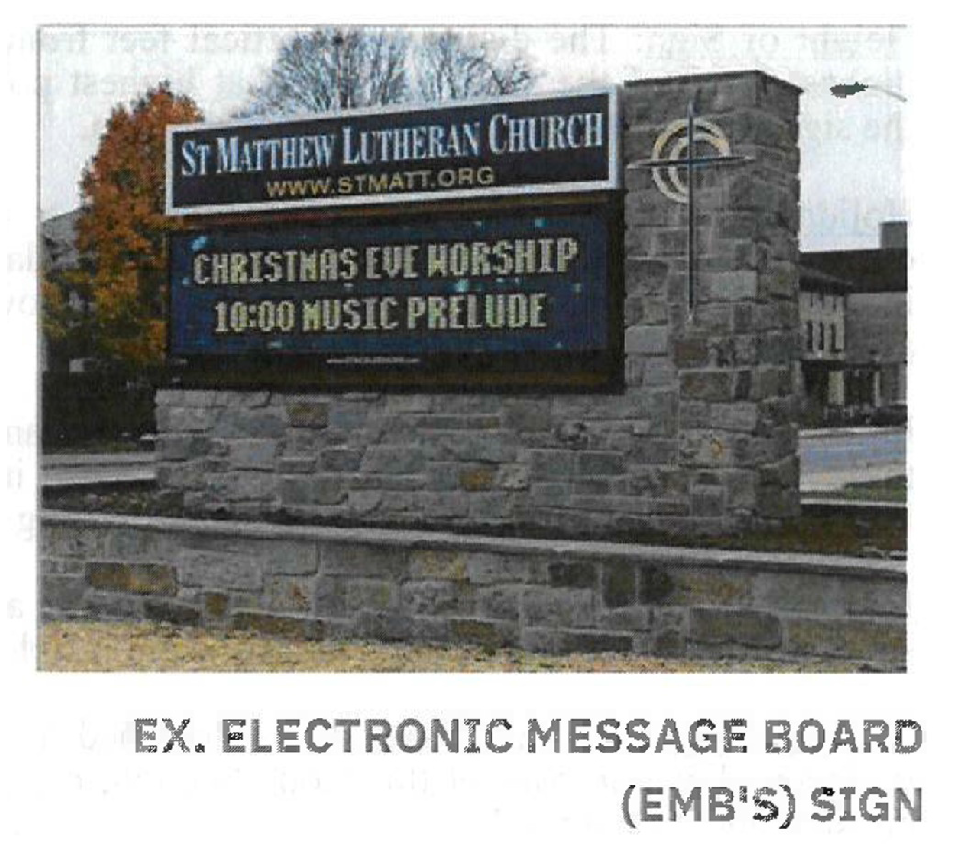
ELECTRONIC MESSAGE CENTER. A sign that utilizes computer generated messages or some other electronic means of changing copy. Signs include displays using incandescent lamps, LEDs, LCDs, and the like.
ERECT. To construct, build, raise, assemble, place, affix, attach, create, or in any other way bring into being or establish, but it shall not include any of the foregoing activities when performed as an incident to the change of advertising message or the normal maintenance or repair of a sign structure.
FASCIA SIGN. A sign attached to, marked or inscribed on, erected or placed against a wall forming part of a building, or supported by or through a wall of a building and having the exposed face thereof on a plane approximately parallel to the plane of such wall and includes a painted wall sign and an awning sign.
FEATHER SIGN. A flexible or rigid pole to which one side of a flexible fabric, generally in the shape of a feather or similar shape, is attached, and which is used for the primary purpose of advertising or attention-getting by the public display of visually communicative images and/or motion.

FIELD. Generally the background upon which the sign copy is applied.
FLAG. A sign with or without characters, letters, illustrations, or ornamentation applied to cloth, paper, plastic, or natural or synthetic fabric of any kind with only such material for a backing. For purposes of this section, except as otherwise provided herein, a FLAG is a "sign."
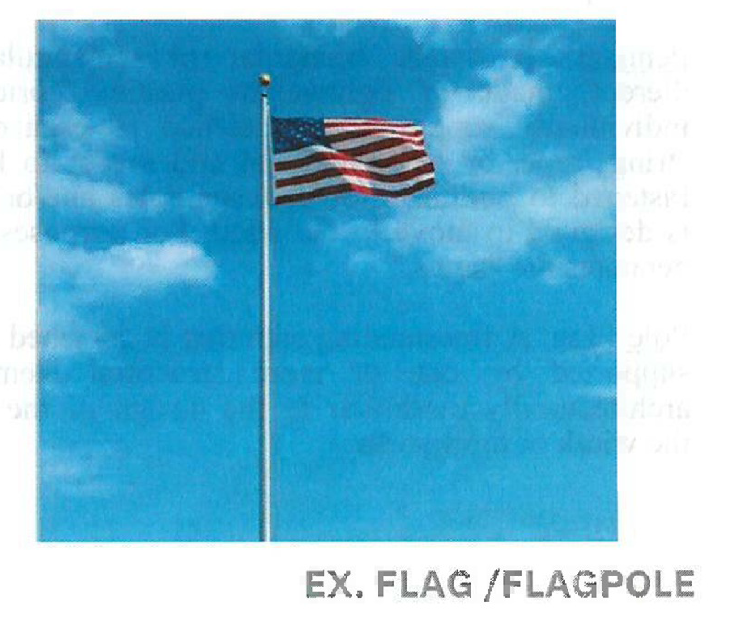
FREESTANDING SIGN. A permanently affixed sign which is wholly independent of a building for support (i.e., freestanding). A ground sign may consist of more than one sign panel, provided all such sign panels are attached to or integrated into one sign structure.
FRONTAGE, BUILDING. The width in linear feet of the front exterior wall of a particular building in which an establishment is located to which the plot or building fronts the main road.
FRONTAGE, ROAD. The distance in linear feet of each lot where it abuts the right-of-way of any public street.
GROUP DEVELOPMENT. Any land development subject to a site plan that includes two or more principal buildings (without a subdivision of land) for the purpose of development (whether immediate or in the future) to be occupied by separate families, firms, businesses, or other enterprises.
HEIGHT OF SIGN. The distance in vertical feet from the ground to the highest point of the sign, whether that highest point is the frame of the sign face or panel or the support of the sign.
HOLIDAY DECORATIONS. Displays erected on a seasonal basis in observance of religious, national, or state holidays, which are not intended to be permanent, and which shall be removed 30 days after observance.
INFLATABLE SIGN. Any sign that is or can be filled with three cubic feet or more of air or gas, including but not limited to inflatable tubes and air powered dancing figurines.
INTERNALLY ILLUMINATED SIGN. A sign illuminated by an internal light source which is viewed through a translucent panel.
MARQUEE SIGN. A sign painted on, attached to, or hung from a marquee. For purposes of this section, MARQUEE SIGNS shall be considered "wall signs.”
MENU BOARD. A permanently mounted structure displaying the bill of fare for a drive-in or drive-thru business.

MONUMENT SIGN. A freestanding sign where the structural part of the sign below the sign face encompasses an area at least 40% of the area of the sign face but no more than 1.5 times the area of the sign face, and which is composed of brick, stone, or other material approved by the Zoning Administrator. A MONUMENT SIGN is a ground sign.
MULTIPLE MESSAGE SIGN. A sign, display, or device which changes the message or copy on the sign electronically by movement or rotation of panels or slats.
NONCONFORMING SIGN. Any sign which lawfully existed on the effective date of this section but which does not conform to the provisions of this section, or which does not comply with this section due to amendments to this chapter since the date of erection of the sign.
OFF-PREMISE SIGN. A sign that advertises goods and services not sold on the premises.
PENNANT. A small, triangular or rectangular flag or multiples thereof, made of lightweight plastic, fabric, or other material, individually supported or attached to each other by means of a string, rope, or other material and meant to be stretched across or fastened to buildings, or between poles and/or structures, and which is designed to move in the wind. For purposes of this section, PENNANTS are "signs.”
POLE SIGN. A freestanding sign that is detached from a building and is supported by one or more structural elements that are either architecturally dissimilar to the design of the sign and/or less than the width of the sign face.
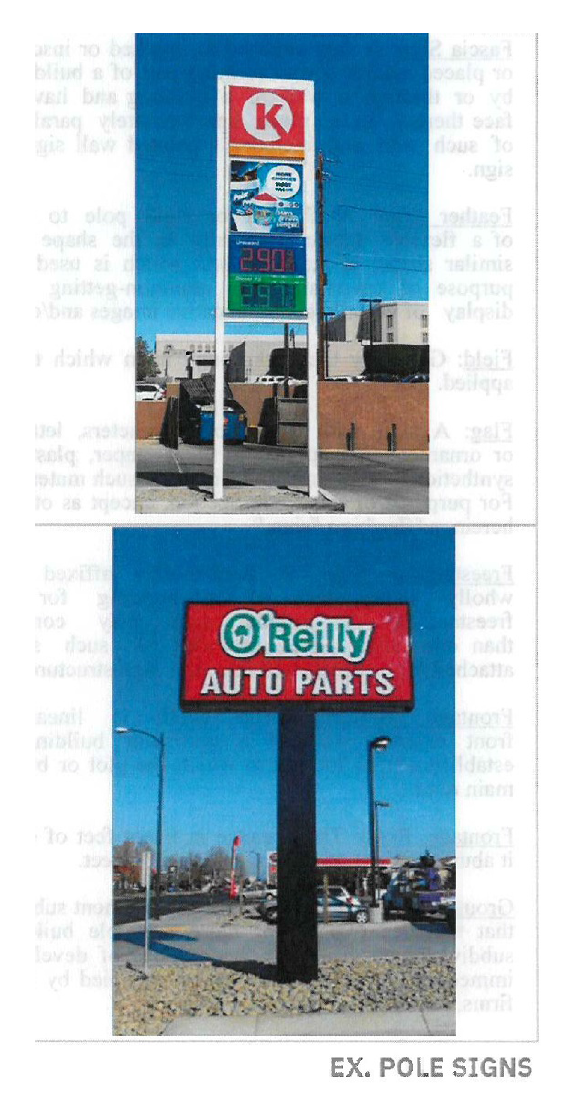
PORTABLE SIGN.
(a) Any sign whether on its own trailer, wheels, or otherwise, which is designed to be transported and that the space provided for advertising messages may be changed at will by the replacement of lettering or symbols (i.e., a changeable copy sign). Even if the wheels or supports of such sign are removed and the sign converted and attached, temporarily or permanently, to the ground or other structure, said sign shall remain a PORTABLE SIGN. In addition, the following shall be deemed a PORTABLE SIGN:
(b) A sign mounted or painted upon a parked vehicle that is positioned for the primary purpose of acting as a sign exposed to the public and is not in use in the ordinary course of carrying out its transportation function. See VEHICLE SIGN.
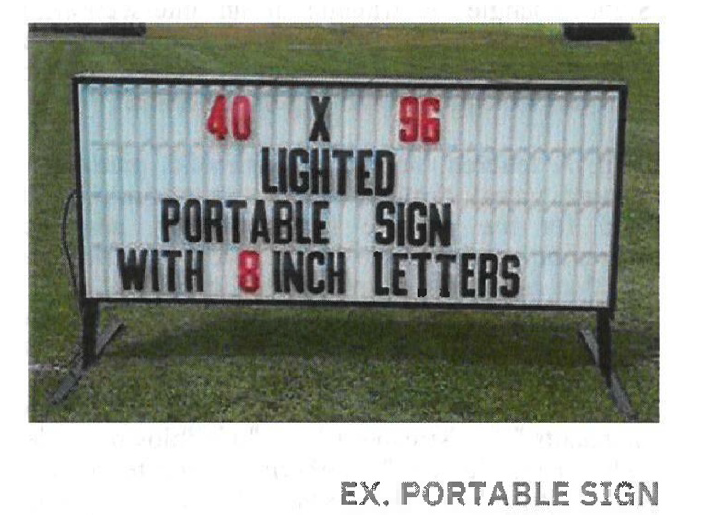
PORTICO. A porch or walkway, open to the outside air, that is covered by a roof supported by columns or pillars, typically leading to the entrance of a building. Signs attached to porticos are considered "wall signs" for purposes of this section.
PRINCIPAL USE SIGN. Any notice or advertisement, which is permitted in conjunction with (but not necessarily containing copy specifically related to) a single principal use or single principal building located on the property, and which may display a noncommercial, commercial, or other message, the content of which is not regulated by this section.
PROJECT ENTRANCE SIGN. A sign located at a discernible entrance into a property consisting of more than one subdivided lot or developed with more than one principal building (e.g., a particular residential subdivision, multi-family residential development, or office, or industrial park).
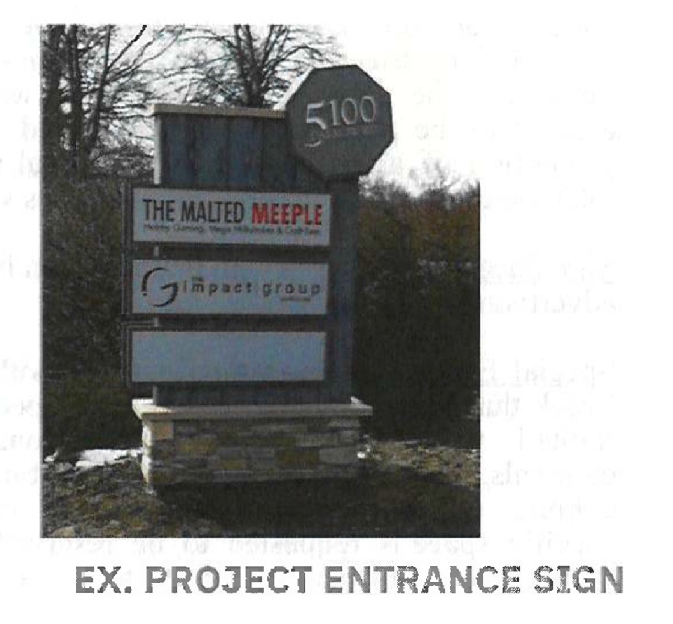
PROJECTING SIGN. A sign projecting more than 14 inches from the outside wall or walls of any building, or canopy, portico, or awning, upon which it is located (see also the tables at the end of this section).
PUBLIC AGENCY. Any governmental body (including city, county and state bodies or agencies, and special purpose districts such as fire, water, and sewer districts) that has jurisdiction over property or infrastructure within the City of Goose Creek.
REPLACEMENT COST. Cost of replacing a structure or building at current costs at the time of the loss, identical to the one that was destroyed or is being replaced, without application of depreciation.
ROOF SIGN. A sign projecting higher than the front building wall or any sign supported by or attached to said roof.
SIDEWALK SIGN. A movable sign not secured or attached to the ground or surface upon which it is located no more than ten feet from main business entrance. Sign to be displayed during business hours of operation only.
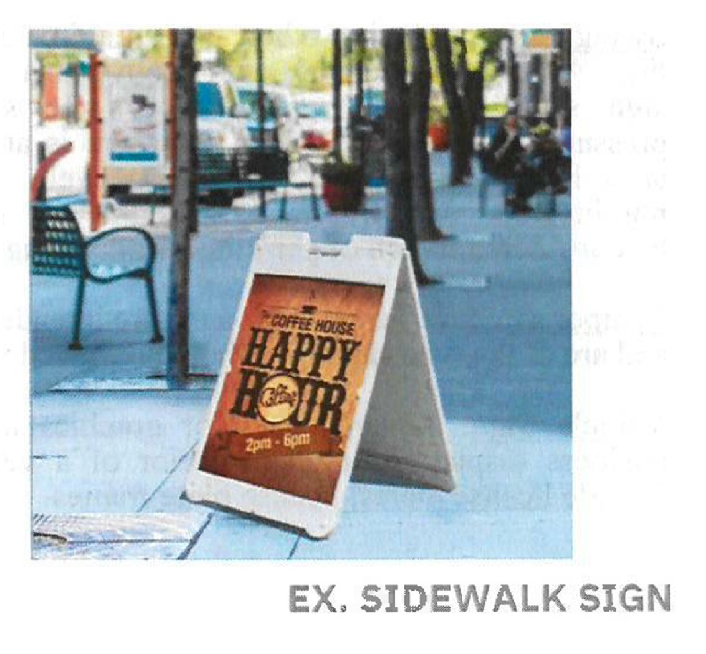
SIGHT TRIANGLE. A triangle at an intersection, formed by the two roads or rights-of-way and a third line, which must be kept clear of obstructions such as hedges so that people in one road can see cars approaching on the other.
SIGN. A lettered, numbered, symbolic, pictorial, illuminated, or colored visual display, device, or communication designed or used for the purpose of identifying, announcing, directing, informing, or bringing to the attention of others the subject there on, that is visible from the public right-of-way, a driveway or parking lot with access to a public right-of-way, or from an adjacent property, except as specifically noted otherwise in this section. For purposes of this section, the term SIGN includes but is not limited to "banners," "balloons,” "flags," "pennants," "streamers," "windblown devices," and "advertising devices." Furthermore, the term SIGN includes the sign structure, supports, lighting system, and any attachments, ornaments, or other features used to draw the attention of the observers.
SIGN FACE. The part of a sign that is or can be used for advertising purposes.

SIGNABLE AREA. In the case of a wall sign, SIGNABLE AREA shall be the building face on which the sign is proposed, excluding windows and doors. In the case of marquees or canopies, SIGNABLE AREA shall be the area of the marquee or canopy wall on which the sign is proposed. For window signs, SIGNABLE AREA shall be measured and calculated on the basis of the proportion of area within each individual window frame, not the total window area of all building windows visible from a street.
SPECIAL EVENT. A non-routine activity within the City of Goose Creek that brings together a number of people including, but not limited to, a performance, exhibition, festivals, concerts, carnivals, arts and craft shows, meeting, assembly, contest, exhibit, ceremony, parade, or athletic competition for which specific space is requested to be reserved. SPECIAL EVENT shall not include casual park use by visitors or tourists.
STREAMERS. See PENNANTS.
SWINGING SIGN. A sign other than an animated sign as defined by this section, where the sign copy area is attached to a sign structure in a way that can be set in motion with pressure, and where the sign structure is attached to a building at a height above normal eye level. This term does not include any freestanding signs. A SWINGING SIGN may be considered in lieu of permitted wall signage.
TEMPORARY SIGN. Temporary signs are intended to be temporary and are of the type capable of being removed with minimal effort.
VEHICLE SIGN. Advertisement or graphics intended to advertise business displayed on the exterior of a vehicle, but does not include license plates or license plate frames.

VISIBLE. Capable of being seen (whether or not legible) without visual aid by a person of normal visual acuity.
WALL SIGN. A single-sided sign with one visible face applied to or mounted to the wall or surface of a building or structure, the display surface of which if attached to a wall or portico and does not project more than 14 inches from the outside wall of such building or structure, or if on an awning or canopy, is flush with the material of said awning or canopy (see also tables at the end of this section).

WAYFINDING SIGN. A system of public signs identifying directions to major public and private facilities or destinations of interest to the general public and typically including graphic elements mounted on separate freestanding poles or incorporated with other sign, light, or traffic standards.
WINDBLOWN OR AIR-BLOWN DEVICE. Any device not otherwise specifically defined in this section that is designed to inform or attract, whether or not such device carries a message, and which all or part of the device is set in motion by wind or mechanically compressed air. For purposes of this section, WINDBLOWN DEVICES are "signs."
WINDOW SIGN. A sign installed on or within two feet of an exterior window or door and intended to be visible from the exterior of the building. Displays which show products or depict services sold on the premises and which are more than two feet from an exterior window or door shall not be classified as window signs (see also tables at the end of this section).
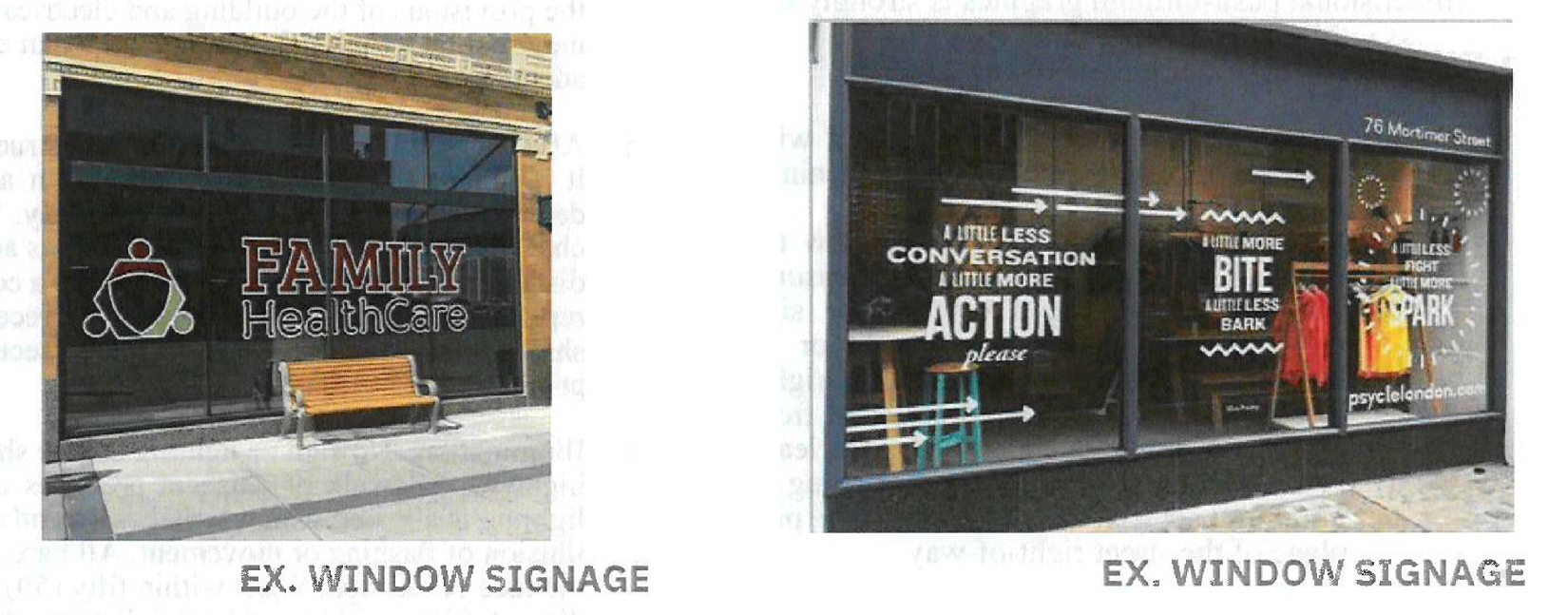
(D) General provisions.
(1) Severability. If any portion of this section is deemed invalid on any basis, it shall be severable from the remaining portions with the intent that remaining portions be construed to accomplish the purposes of this section.
(2) General standards.
(a) A permit shall be required for the erection, alteration, or reconstruction of any sign intended for view from the public right-of-way unless otherwise noted and shall be issued by the Zoning Administrator in accordance with this section.
(b) No sign shall interfere with motorists' vision, nor simulate traffic control or emergency vehicle lighting.
(c) Hazard or directional signage. Signs less than four square feet in area pointing out dangers to human safety existing immediately around the sign or safety devices on the property such as "flammable”, "dangerous dog”, "fire extinguisher", "step", "fire escape", "high voltage", "danger”, "keep out", "no trespassing" or similar words and/or symbols, shall not be included in computing maximum allowable sign area. These signs shall not include any advertisements or the logo or colors of a business or other information not directly related to the danger or safety device or method.
(d) Compliance with building and electrical codes. All signs in their installation, maintenance, and removal must comply with the provisions of the building and electrical codes adopted by the city. The Zoning Administrator or Building Official may require additional certification by an engineer when he/she is uncertain that the proposed method of construction is adequate.
(e) All signs shall be maintained in sound structural condition. No sign shall be allowed to deteriorate to a condition in which it requires repairs or renovations in an amount that exceeds 50% of its current replacement cost as determined by a licensed sign company. This includes signs which are defaced, missing some or all illumination or characters, and whose finishes or facings are chipping, peeling, cracking, or broken in any way shall be deemed to be in disrepair. Signs that deteriorate to such a condition that they are in violation of this section shall be either removed or replaced within 60 days after receipt of notification from the Zoning Administrator. If a sign is replaced, it shall comply with the standards in this section at the time of replacement. Nonconforming signs are subject to the provisions of division (I) below.
(f) Illumination. No sign or lighting device shall be placed or directed to permit beams or illumination upon a public road, highway, sidewalk or adjacent premises or residence, or skyward so as to cause a traffic hazard or nuisance. No sign lighting is allowed which switches on and off intermittently, changes intensity and/or color, or otherwise creates an illusion of flashing or movement. All bare light bulbs, except bulbs less than 15 watts, shall be directed toward the face of the sign. Signs within 50 feet of a residential district shall be shielded from casting glare into the district. Signs within residential districts shall be shielded from casting illumination into residences within 100 feet. The use of backlit (halo), individually cut reverse channel letter signs, or stenciled panels with three-dimensional push-through graphics is strongly encouraged.
(g) Height, setback, measurement, and location.
1. Freestanding signs shall not extend within a street right-of-way. Freestanding signs shall not obstruct vision between a height of three feet and nine feet, measured from street grade closest to the sign, within the sight triangle.
2. When a sign's base is located below the grade of a road that is adjacent to the property and to which it is oriented, the sign height shall be measured from the grade of that road centerline.
3. The dimensional requirements for sign faces shall be considered the allowable area of any one sign face, whether the sign is single or double-faced. No projecting sign shall project more than 24 inches over a sidewalk right-of-way, provided that no part of the sign shall encroach within a vertical plane measured two feet from the edge of the adjacent street pavement. The bottom edge of the sign must maintain a clearance of at least eight feet from the finish grade level below the sign.
4. Free-standing monument signs, awning signs, canopy signs, marquee signs, and temporary signs shall have a minimum setback of ten feet from the property line, and shall not be installed within, nor project into the vertical plane of the street right-of-way.
5. Fascia signs may project no more than 12 inches from a wall.
6. No sign shall be attached to or obstruct any fire escape or opening intended as a firefighting point of ingress or egress, interfere with any opening required for legal ventilation or prevent free passage from one part of a roof to another.
7. Street furniture, such as benches, waste receptacles, fountains and the like shall not be used for advertising purposes.
(h) The placement of signs shall ensure visibility at intersections and ingress and egress points.
(3) Applicability.
(a) General. Unless exempted in accordance with this section, no sign allowed by this section shall be erected, repaired, altered, relocated, maintained or displayed without first being issued a sign permit and complying with the relevant standards of this section.
(b) Responsibility for compliance. Review for compliance with the standards of this section shall occur at the time of application for a sign permit.
(c) Termination. If a business discontinues the use of a site, sign faces/messages used by the business that were previously erected on the site or off-premise freestanding signs shall be considered as abandoned and shall be fully removed within 120 days of vacating the site. General information such as "for lease" or "for sale" and contact information is permitted to assist in leasing or selling the site. It shall be the responsibility of the owner of the land to remove all abandoned signs. Abandoned signs may not be leased, rented, or sold for off-site advertising.
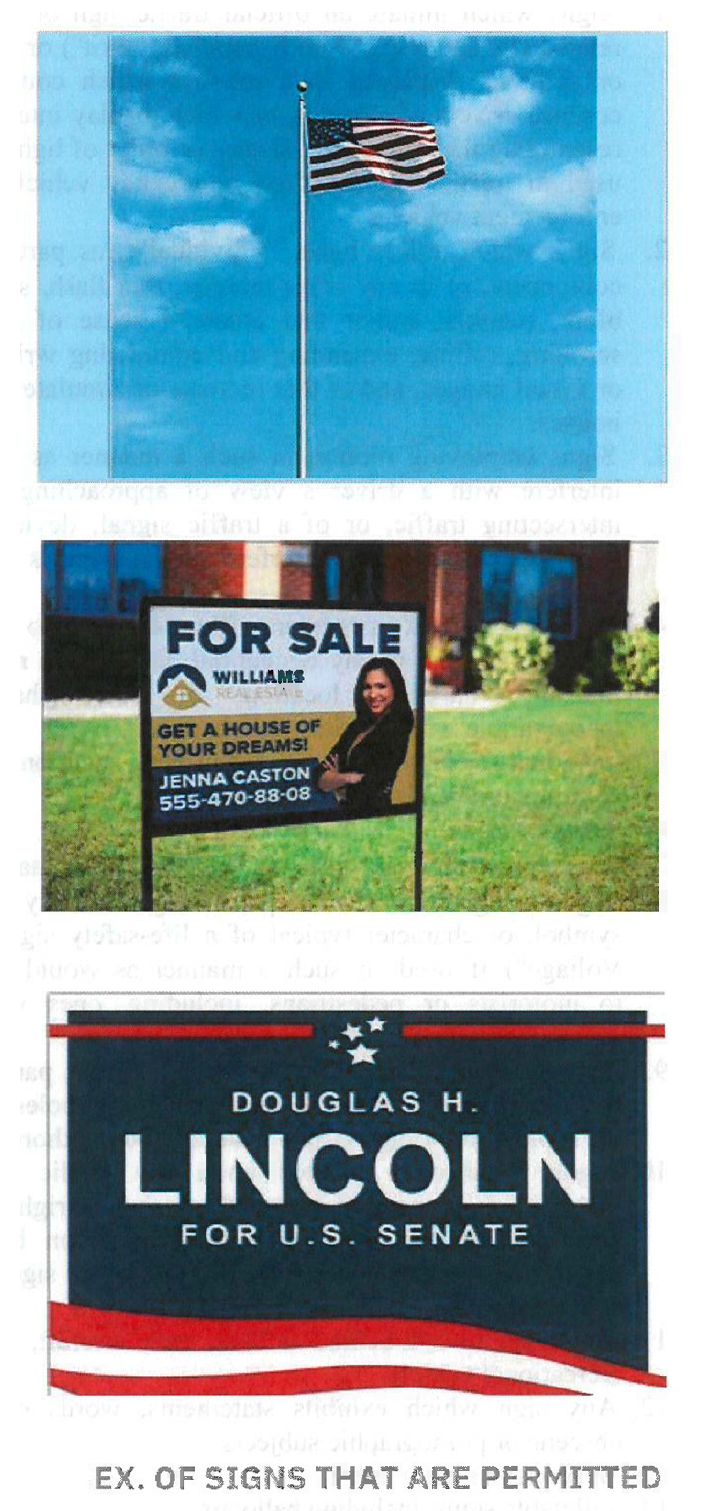
(E) Prohibited signs. Unless specifically permitted elsewhere, the following signs shall be prohibited in the City of Goose Creek:
(1) Signs which imitate an official traffic sign or signal, safety-related signage (e.g., "fire escape” or "exit”) or contain words or symbols displayed in a manner which could mislead or confuse drivers of vehicles, or which display intermittent lights resembling the color, size, shapes or order of lights customarily used in traffic signals, on emergency vehicles or on law enforcement vehicles;
(2) Signs which utilize lights, individually, as part of a lighting component, or in any other manner, that flash, strobe, pulsate, blink, twinkle, and/or that create a sense of movement by scrolling, rolling, expanding and contracting written messages or visual images, and/or that recreate or simulate moving video images;
(3) Signs employing motion in such a manner as to obstruct or interfere with a driver's view of approaching, merging, or intersecting traffic, or of a traffic signal, device or sign, or which would otherwise interfere with a driver's operation of a motor vehicle;
(4) Sign lighting that casts intense illumination onto any residential premises located in any residential district in a manner that by intensity, duration, location, or other characteristic is incompatible with a residential character;
(5) Stationary vehicle signs present in the same location for more than 48 hours or abandoned vehicle signs;
(6) Portable signs;
(7) Any sign which emits a sound, odor, or visible matter;
(8) Signs using the words "stop”, "danger" or any word, phrase, symbol, or character typical of a life-safety sign (e.g., "high voltage") if used in such a manner as would pose a risk to motorists or pedestrians, including ones which pose a substantial risk of confusing a driver;
(9) Signs painted on or attached to trees, fences, parking bollards, rocks or natural features, telephone or utility poles or painted on the roofs of buildings visible from any public thoroughfare;
(10) Signs installed or erected upon any public right-of-way including the unpaved portion of any road or right-of-way. This does not apply to signs installed by or on behalf of any governmental entity having the right to install signs of that type at that location;
(11) Any sign towed behind a boat, raft, aircraft, helicopter, or recreational vehicle;
(12) Any sign which exhibits statements, words or pictures of obscene or pornographic subjects;
(13) Beacons or search lights;
(14) Inflatable signs, including balloons;
(15) Streamers, ribbons, windblown propellers, feathers, strung light bulbs, pennants, bench or furniture signs;
(16) Off-premises signs except for advertising signs;
(17) Abandoned signs;
(18) Dilapidated signs;
(19) Bandit signs;
(20) Flags containing text or graphics advertising a business, service, or product;
(21) Pylon and pole signs;
(22) Permanent banner signs;
(23) Signs in wetlands shall not be permitted except by government entities or with the permission of government entities;
(24) Internally illuminated awning signs;
(25) Signs erected without the permission of the owner or other person having a legal right to install signs at that location; and
(26) Signs erected on the property of the City of Goose Creek, except those erected by or on behalf of the City of Goose Creek.
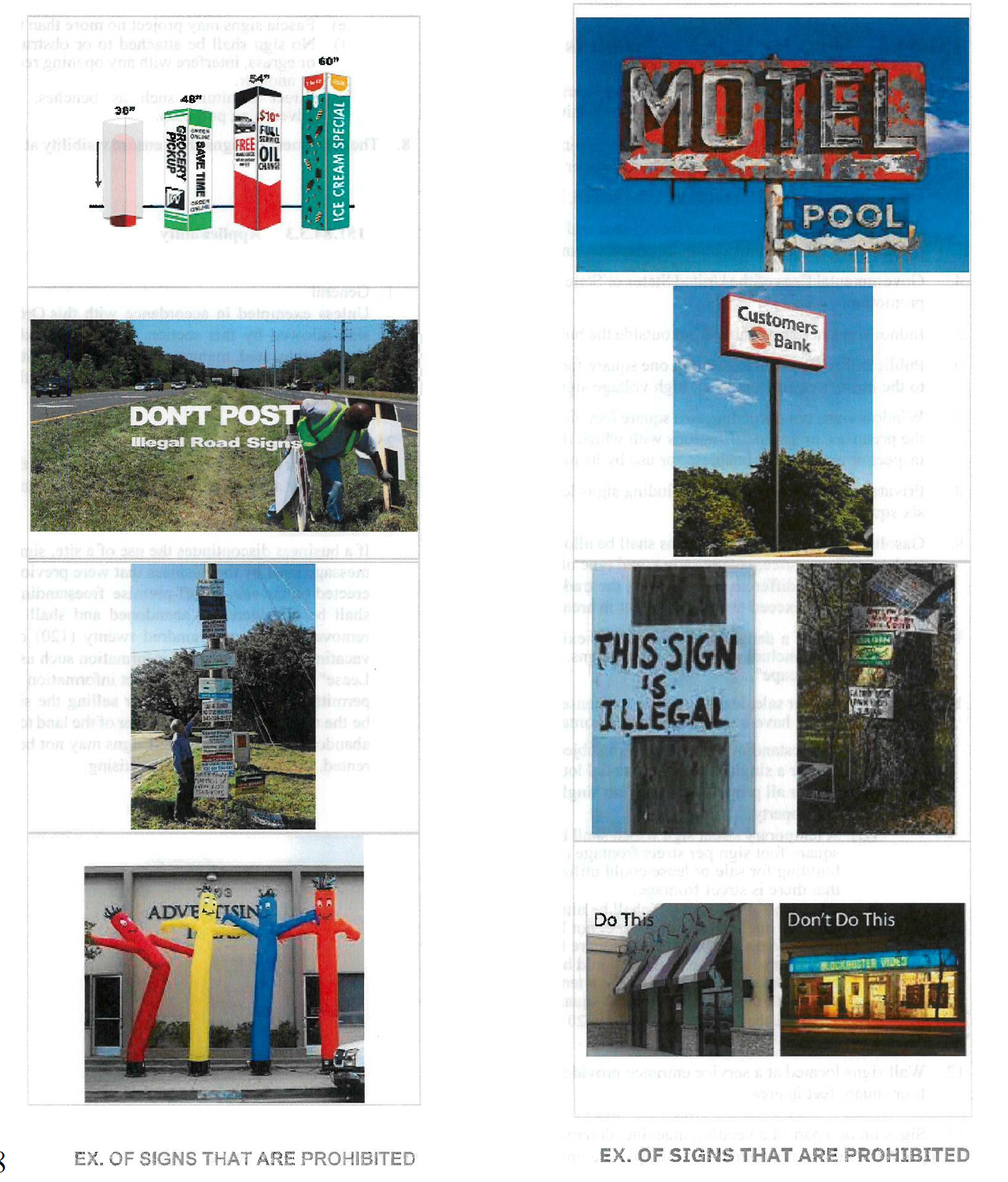
(F) Signs for which a permit is not required. A permit shall not be required for the following types of signs, provided all other applicable provisions of this section are met. Such signs shall not be considered in determining the allowable number or size of signs on a lot.
(1) Traffic signs, including directional, wayfinding, warning and information signs, owned by the city, county or SCDOT, and located in public rights-of-way or other adjacent property;
(2) Official notices issued, or required to be posted, by any federal, state, county or municipal government;
(3) Signs not exceeding one square foot in area and bearing only the property address, names of owners or occupants of the premises, or other identification of premises, and not having a commercial message;
(4) Governmental flags of the United States or State of South Carolina except when displayed in connection with commercial promotion;
(5) Indoor signs not observable from outside the building;
(6) Public utility signs not exceeding one square foot in area provided they are placed on the utility's equipment or adjacent to the utility's equipment (e.g., high voltage sign or the name of the utility that owns the pole);
(7) Window signs not exceeding two square feet, indicating business hours of operation, credit cards which are accepted on the premises, or group affiliations with which the business is associated, or clubs or groups which utilize, recommend, inspect or approve the business for use by its members, and non-illuminated "open" and "closed" signs;
(8) Private traffic direction and wayfinding signs located on the premises for which directions are indicated, not exceeding six square feet for each sign;
(9) Gasoline station pump signs. Signs shall be allowed on gasoline station pumps so as to provide information to the public such as gallons, price, octane rating, and type of fuel. As the trade name of the business is often times incorporated into the name for the different types of fuel, the trade name and any associated symbols shall be permitted on the pumps as flat signs not to exceed three square feet in area per sign face and shall not extend above the top of the fuel pump;
(10) Signs to warn of a danger to human safety existing immediately around the sign or safety devices or methods in the area of the sign, including no trespassing signs. Examples of this would include "keep out", "flammable", "dangerous dog" or "fire escape";
(11) If a property is for sale, lease or rent by a licensed real estate agent or via a bona fide for sale by owner or private listing, the property may have one sign per street frontage restricted as follows:
(a) A freestanding temporary sign subject to the following:
1. For a single-family residential lot, one eight square foot sign is allowed per property.
2. For all properties other than single-family residential, one 32 square foot sign is allowed per property.
(b) A temporary street sign which shall be restricted to non-residential areas only and shall be limited to one 32 square foot sign per street frontage of the building on the side facing the street. Thus, a non-residential building for sale or lease could utilize this provision to have a "for sale" or "for lease" sign on each side that there is street frontage.
(c) The signs in (a) and (b) shall be alternatives for non-residential structures. Each street frontage shall be allowed one sign of either type, not both. Thus, a home for sale could have a freestanding temporary freestanding sign up to eight square foot per street frontage. If the house had frontage on two sides, then one temporary freestanding sign would be allowed on each street. On the other hand, a commercial property held out for sale or lease might have a temporary sign up to 32 square feet on one side and a temporary sign up to 32 square feet affixed to the building on another side if it had two street frontages.
(d) The sign shall be removed within 20 days of the property being sold, rented or leased;
(12) Wall signs located at a service entrance, provided there is not more than one per business and the sign does not exceed four square feet in area;
(13) Signs on or a part of a vending machine, donation container, and similar accessory equipment, which are an integral part of the equipment and advertise only the products or services available from that equipment;
(14) Scoreboards and other signs at outdoor recreation facilities, and oriented to the interior of the facility;
(15) Temporary residential signage not otherwise prohibited and as specifically outlined in division (H)(1) that does not exceed 32 square feet, ground mounted, less than four feet in height and located at least ten feet away from any right-of-way; and
(16) Signs during elections and referendums. During the period 30 days prior to an election or referendum applicable to citizens of the City of Goose Creek and seven days after such an election or referendum, a property owner or tenant in possession may post up to four non-commercial signs and another one for each 100 feet of street frontage. Signs shall not exceed eight square feet per sign face in residential areas and 32 square feet in commercial areas.
(G) Regulations by zoning district. A permit shall be obtained prior to the erection, installation, or display of any signs except those as described in division (F) above. The following permanent signs and no others shall be allowed, subject to the issuance of a sign permit and compliance with all applicable development standards of this chapter. The following regulations apply to the following specified types of signs:
(1) Residential zoning district.
(a) For a property used principally as a residence, one sign not to exceed ten square feet, with a minimum allowance of one sign per separate dwelling unit. Each residence gets one sign.
(b) For property principally used as a residence, one temporary sign not to exceed eight square feet which is displayed no more than three times per year for a total not to exceed 21 days total in any calendar year. This will allow for garage and yard sale signs, or special celebration signs such as for a graduation or birthday. The three times per year and 21 total days limit applies even if the message on the sign or sign itself changes.
(c) For each property in a residential district with structures that have a lawful principal use other than a residence, one sign, bulletin board or entrance marker not exceeding 32 square feet. This only applies to a lawful principal use of a property for something other than a residence in the residential area. This does not apply to home occupation businesses.
(d) Such signs shall be permanent in nature. The right to this type of sign ends when the structures on the property are no longer principally used for a non-residence.
(e) While a property has a valid building permit for construction or a substantial renovation, a sign not over 20 square feet in area, to be removed within 30 days after project completion. This would allow for a sign reflecting the contractor or subcontractors and/or the financing company.
(f) Subdivision entrance sign(s), to be approved by the Zoning Administrator.
(2) Commercial and industrial zoning districts. Signs on the wall of a building (including signs attached flat against the wall, painted wall signs and projecting signs) shall meet the following requirements:
(a) Window signs. Window signs are those signs which are attached to or located within 12 inches of the interior of a window. Window signs may be displayed in ground floor windows only. Allowances for the number and size of window signs are provided in division (L) below.
(b) Building signs.
1. Building signs are those types of signs attached to a building, and include wall signs, awning signs, and projecting signs. Allowances for the number and size of building signs are provided in division (L) below. Applicants are encouraged to submit sign plans for evaluation during the building permit review process.
2. Standards for all building signs.
a. Building signs for businesses occupying space above the ground floor of a building are not allowed. Identification for these businesses should be limited to an area on or adjacent to the ground floor door leading to the upper floor.
b. The use of awnings for the primary purpose of providing signage is not appropriate. Internal illumination of semi-opaque awnings is not permitted.
c. The use of flat panel, cabinet or box signs are only permitted with opaque field/background.
3. Façade repair process. Repair of the façade is required during building sign replacement. The repair of any holes, electrical wiring, paint discoloration, exposed raceways, obsolete signage, or other repairs as noted by the Zoning Administrator is required prior to final approval.
(c) Freestanding signs.
1. Freestanding signs are those types of signs that are supported by a structure secured to the ground and are wholly independent of any building, other than a proportionate sign structure, for support. Freestanding signs include monument signs. Allowances for the number and size of freestanding signs are provided in division (L) below. Applicants are encouraged to submit sign plans for evaluation during the site plan and building permit review package.
a. Lighting. Free standing signs may be illuminated internally provided the field/background is opaque, allowing only the copy (letters and logo) to be illuminated.
b. Address. The address of the property shall be displayed on the freestanding sign oriented to the street on which the address is assigned. The address shall be displayed using a character size of at least six inches tall. Signs perpendicular to vehicular travel shall have the address on both sides of the signage. Address shall be illuminated.
c. Landscaping. Monument style signs are an integral part of the overall built and landscaped environment of a site. Landscaping around the base of a freestanding sign must be used to soften a blank base of a sign and to help integrate a sign into its surroundings. Evergreen foundation plantings are required. A landscape plan and schedule must be submitted with completed sign application. Plantings must not exceed a height that would interfere with foot or vehicle traffic or visibility of the sign.
d. A business may substitute a freestanding sign for one additional building sign, provided that the cumulative square footage does not exceed the maximum allowable area schedule that must be submitted with completed sign application.
2. Electronic Message Board (EMBs) signs.
a. Permitted locations. Schools, places of worship, and governmental buildings, including municipal complexes.
b. Sign, style, height, width, and setback. The electronic message board shall be integrated into a monument sign with a brick or stone base. The sign shall not exceed eight feet in height and ten feet in width, including the base and all brickwork. The sign shall be setback with a minimum of ten feet from the front property line. The electronic message board may display letters only, with a maximum of three lines of text. Only numbers and text are permitted.
c. Electronic message board sign area. The maximum area of the electronic message board sign component shall not exceed 40 square feet or 50% of the total sign area, whichever is less.
d. Color and brightness control. Message copy shall be limited to one color (Zoning Administrator to approve color; school spirit colors allowed upon approval), white or amber, on a black background. The sign shall be equipped with photosensitive equipment which automatically adjusts to the brightness and contrast of the sign in direct relation to the ambient outdoor illumination.
e. Interval. The sign may only display one new message per hour unless required for emergencies.
f. Movement. The use of animation, flashing, scrolling, or blinking characters is prohibited.
3. Electronic Message Center (EMC) signs. To be permitted for service/gas station fuel pricing.
a. EMC illumination measurement criteria. The illuminance of an EMC shall be measured with an illuminance meter set to measure foot-candles accurate to at least two decimals. Illuminance shall be measured with the EMC off, and again with the EMC displaying a white image for a full color-capable EMC, or a solid message for a single-color EMC. All measurements shall be taken as close as practical to a perpendicular plane of the sign at the distance determined by the total square footage of the EMC, as set forth in the accompanying sign area of a sign versus measurement distance table.
b. EMC illumination limits. The difference between the off and solid-message measurements using the EMC measurement criteria shall not exceed 0.3 foot-candles at night.
c. Dimming capabilities. All permitted EMCs shall be equipped with a sensor or other device that automatically determines the ambient illumination and is programmed to automatically dim according to ambient light conditions, or that can be adjusted to comply with the 0.3 foot-candle measurements.
d. Limits of EMC use. The EMC shall only be permitted on gas stations and the price for gasoline displayed in RED numerals and GREEN for diesel fuel with black background.
e. Interval. Displays shall only change a fuel price adjustment. It is not permitted to cycle through various fuel grades or payment options.
4. Freestanding signs. For group developments where multi-tenant freestanding signs are used, the number of tenant panels on each sign shall be limited to five, plus the name of the development. Allowances for the number and size of multi-tenant signs are provided in division (L) below. Businesses located in shopping centers are not authorized to erect freestanding signs.
a. Address. The address of the property shall be displayed on the freestanding sign oriented to the street on which the address is assigned. The address shall be displayed using a character size of at least six inches tall. Signs perpendicular to vehicular travel shall have the address on both sides of the signage.
b. Master sign program for multi-tenant development shall be submitted as part of the permit review process.
(H) Temporary event signs and display of flags.
(1) Special event signs and banners. Special event signs/banners are restricted to businesses, churches, schools, and government entities other than the City of Goose Creek and are subject to the following conditions and limitations:
(a) Each business, church or school is limited to two special event sign/banners during the calendar year and must obtain a permit from the Zoning Administrator.
(b) All temporary event signage must be temporary in nature.
(c) Only one banner or special event sign is allowed for each special event at any given time.
(d) Banners and special event signs may be displayed a maximum of 30 days and no more than twice per year. Applicants shall indicate on the permit the days the special event signs or banners will be displayed.
(e) Banners and special event signage shall be properly secured and maintained at all times and shall not interfere with pedestrian or vehicular movement. Banners shall not be strewn between buildings, utility poles, trees or over rights-of-ways or public sidewalks.
(f) The maximum size of a banner or special event sign shall be 50 square feet.
(g) Faded, tattered, or unsecured banners and mounting hardware which is broken or bent shall be removed or repaired in a timely manner.
(h) Restrictions are not applicable to signs installed by the City of Goose Creek.
(2) Display of national, state, and corporate flags.
(a) The maximum height above grade for a ground mounted flagpole shall be 35 feet or 15 feet above the highest point of the roof.
(b) No individual flag may exceed 50 square feet in area.
(c) No more than three flags may be displayed from a single pole or device. No more than three flags maybe displayed on a single site, lot or parcel, whether on single or multiple poles.
(I) Nonconforming signs and permission.
(1) General.
(a) Any sign lawfully existing at the time of the enactment of this section or any amendment thereto but which is not permitted either by type of sign, location, or district or which fails to meet the standards or regulations shall be classified as either nonconforming or noncomplying as per definitions.
(b) Freestanding signs existing on the effective date of this section which do not conform to the regulations set forth in this section shall become nonconforming signs and shall be discontinued, replaced, or brought into conformance by January 1, 2033. No exceptions or variances shall be permitted on the removal of nonconforming signs.
(c) All signs, whether nonconforming or conforming signs, shall be removed if they present an unreasonable risk of danger to the public based on the determination of the Building Official based on appropriate sections of the adopted building code or upon determination by the Zoning Administrator, the Goose Creek Municipal Code, and/or various provisions of this section deeming such signs as being dilapidated and constituting a definite health hazard to the public.
(d) In addition, all off-premise signs are prohibited except those authorized as being exempt. Existing advertising signs currently in the city limits or those that are annexed into the city shall be allowed to continue as nonconforming signs. These nonconforming signs shall not be allowed to be enlarged, extended or converted to electronic billboards. Change of copy and regular/ordinary maintenance shall be allowed.
(2) Alterations to nonconforming and noncomplying signs. A nonconforming or noncomplying sign may be altered subject to the following conditions:
(a) The nonconforming or noncomplying sign structure shall not increase the degree of nonconforming or noncompliant portions of the sign, nor shall they be increased to exceed the height and area limits of the site on which it is located.
(b) Alterations are limited to the changing of a copy of a permitted changeable copy sign, or the painting or refinishing of the surface of a sign face or sign structure so as to maintain an adequate appearance. The alterations of advertising signs which are nonconforming or noncomplying must adhere to all the requirements cited in this section. In all cases, the business owner shall obtain a sign permit in accordance with the terms of this section.
(c) A nonconforming or noncomplying sign structure shall not be re-erected, relocated or replaced unless it is brought into compliance with the requirements of this section, including all applicable yard, setback, size, and height requirements as stipulated within this section.
(d) Obsolete sign copy shall be removed by covering the sign face, replacing the sign face with a blank sign face, or replacing the obsolete sign copy with sign copy that is not obsolete. Failure to comply with such notice within the time specified in such notice shall be considered a violation of the terms of this section.
(e) All nonconforming signs shall be removed upon a business ceasing operations for more than 90 consecutive days. Nonconforming sign structures shall be removed by the owner of the property, his/her agent, or the person having the beneficial use of the building or structure upon which such sign or sign structure is erected within 30 days after written notification from the Zoning Administrator or his/her representative.
(f) All nonconforming signs shall be removed when the current business undergoes a renovation in which the renovation costs are greater than 50% of the sign replacement cost.
(J) Calculation of display area for signage.
(1) General. The sign face area shall be the advertising display surface of the sign.
(2) Size of sign face area. In the case of freestanding signs, the sign face area consists of the entire surface area of the sign on which copy could be placed.
(3) Supporting structure not counted. The supporting structure or bracing of a sign shall not be counted as part of sign face area unless such structure or bracing is made a part of the sign's message.
(4) Co-location. Individual uses on adjoining lands may place their individual freestanding signage on a single sign support structure, provided the combined sign face area does not exceed the amount of sign face area permitted if the freestanding signs would have been constructed separately. Sign support structures shall comply with the height limits regardless of the number of collocated signage.
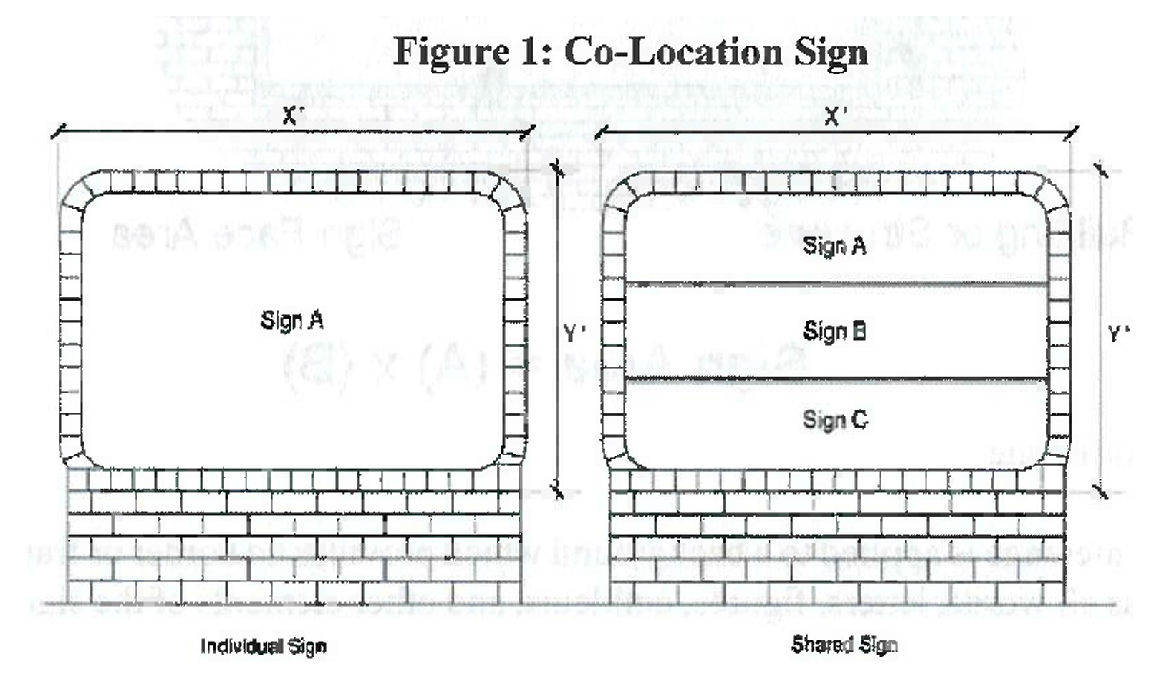
(5) Two-sided signs. Where a sign has two identical display faces back-to-back, the area of only one face shall be considered the sign face area. Where a sign has more than one display face, all areas that can be viewed simultaneously shall be considered the sign face area as depicted in Figure 2, Two-Sided Signs:
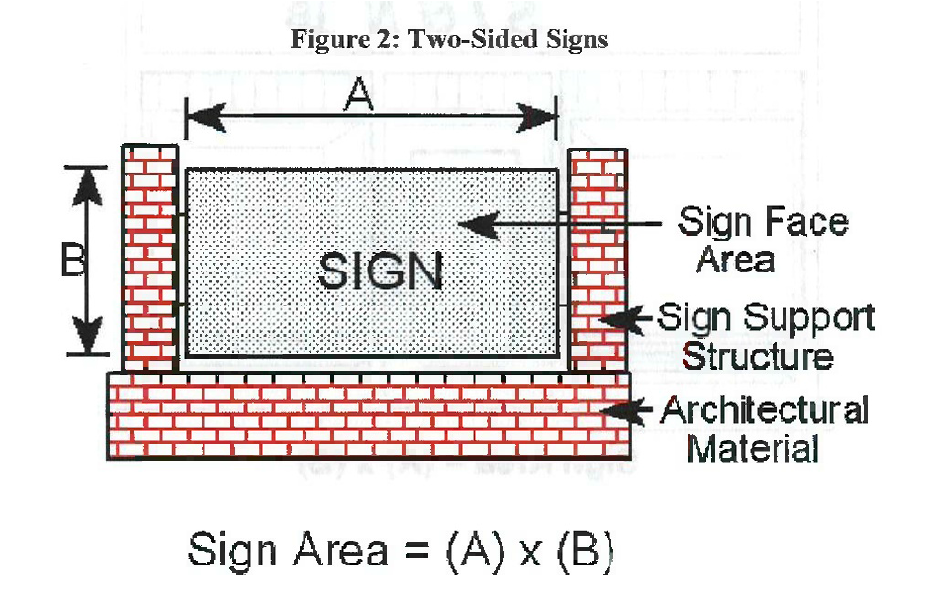
(6) Signs with a background. In the case of a sign whose message is fabricated together with the background which borders or frames that message, the sign face area shall be the total area of the entire background as depicted in Figure 3, Signs with a Background:
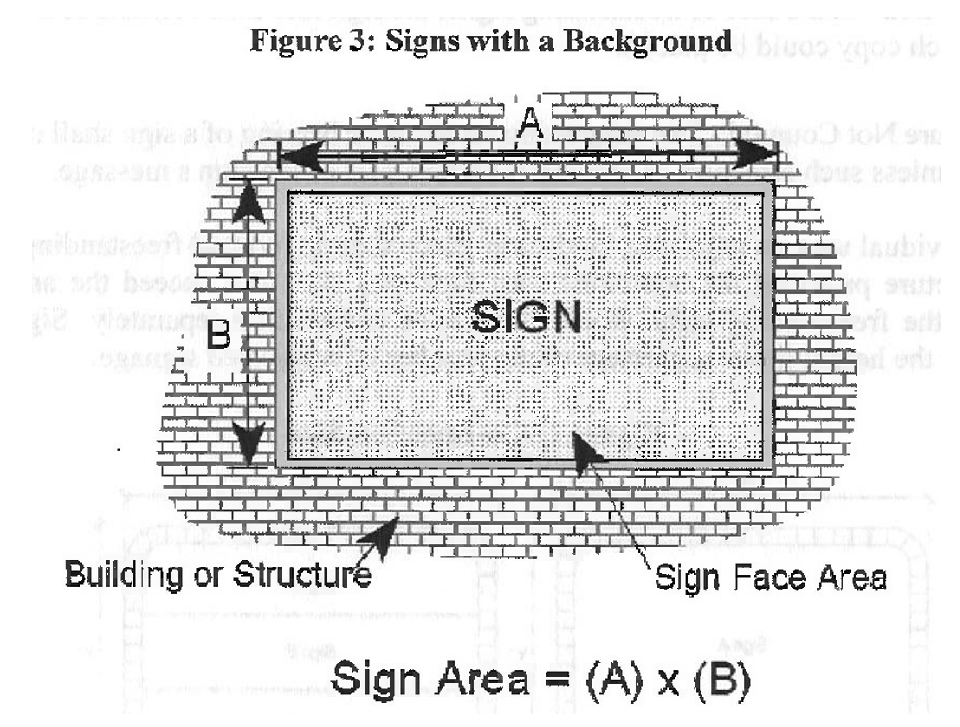
(7) Signs with no border or frame. In the case of a sign whose message is applied to a background which provides no border or frame, sign face area shall be the area that can encompass all words, letters, figures, emblems, and other elements of the sign message as depicted in Figure 4.
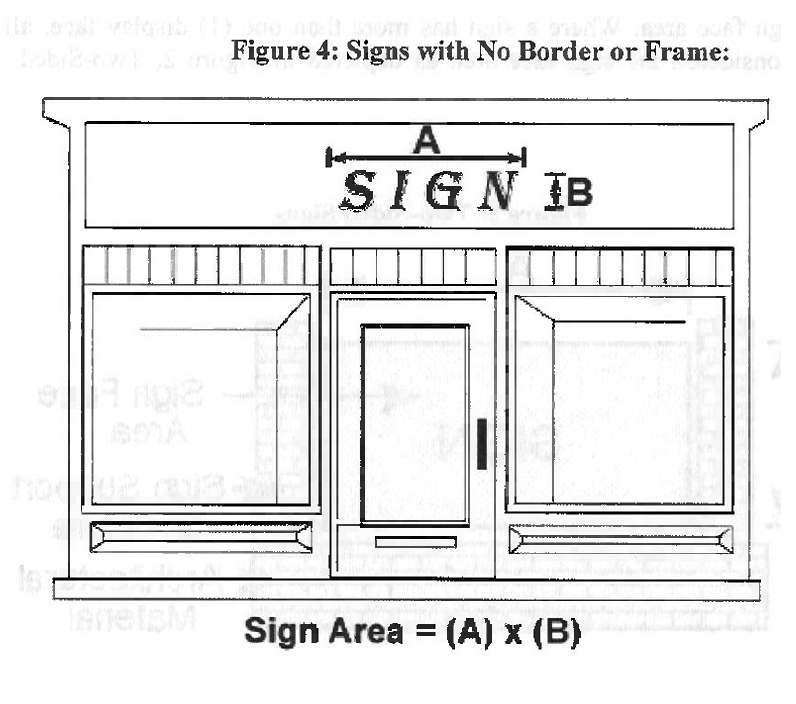
(8) Sign height.
(a) No freestanding sign shall exceed ten feet in height as measured from the base of the sign in all non-residential zoning districts.
(b) Sign height shall be measured from the base of the sign at normal grade to the highest point of the sign support structure, or sign face, whichever is higher. For the purposes of this division, NORMAL GRADE shall mean the newly established grade after construction, not including any filling, berming, mounding, or excavating solely for the purpose of locating the sign. In cases where the normal grade is below the grade of the street to which the sign is oriented, sign height shall be computed on the assumption that the elevation of the normal grade at the base of the sign is equal to the elevation of the crown of the adjacent street as depicted in Figure 5.

(c) For signs placed on a landscaped berm or raised landscape area, such as a planter or retaining wall, the height of the berm or raised area is included when calculating the height of the size as depicted in Figure 6.
(d) The Zoning Administrator may allow sign heights and/or area in excess of the maximum in cases where additional height is required to raise the base of the sign to the mean elevation (street level) or the fronting street where displayed.

(K) Sign application process.
(1) General. Applications for sign permits shall include a scaled (high-resolution digital) drawing of the sign, which depicts and describes:
(a) Size;
(b) Shape;
(c) Colors;
(d) Materials to be utilized;
(e) Copy/wording and designs;
(f) Illumination type and electrical detail;
(g) Location on the building of proposed and existing signs;
(h) Photos of adjacent storefronts and actual sign (if it already exists); and
(i) Material and color samples.
(2) Freestanding ground signs. In addition, permit applications for freestanding signs shall be accompanied by a scaled (high-resolution digital) plot plan or sketch of the site, to show:
(a) Font;
(b) Colors;
(c) Location on the property (on a plat) of proposed and existing signs with dimensions from property lines;
(d) Dimensions of the sign;
(e) Support structure to be utilized;
(f) Electrical sources;
(g) Base landscaping; and
(h) Material and color samples.
(3) Application determination.
(a) The permit request shall be investigated by the Zoning Administrator, and action taken for approval or denial.
(b) Awning signs, certain wall signs, freestanding signs, temporary signs, and the like on existing buildings or replacing existing signs require design review and approval by the Zoning Administrator. If a sign is authorized as described in this section, a sign permit will be issued. The permit expiration date of temporary sign permit will be indicated on the permit.
(c) Appeals of a decision by the Zoning Administrator shall be made in writing to the Board of Zoning Appeals. Appeals of the Board of Zoning Appeals shall be made to the Circuit Court within 30 days of the date of decision by the Board of Zoning Appeals.
(d) Incomplete permits will result in delayed action of approval or denial.
(4) Fees. Fees shall be paid upon filing for a sign permit, in the amount established in the fee schedule on file in the City Clerk's office. Signs erected, or work begun, without obtaining a permit, shall be subject to penalty as referenced within the penalty section.
(a) Signs exempt from permit are exempt from fees but shall conform in all other respects to these regulations.
(b) A sign confiscated in violation of this section and still available may be reclaimed upon payment of a $25 fee.
(5) Enforcement.
(a) The Zoning Administrator or designee may send notice to the sign owner and/or the business for which the sign represents, stating the nature of the violation and granting an appropriate period of time to correct the violation. Signs which are found to be in violation of the provisions of this chapter shall be subject to the following provisions. Where notice is required, such notice shall be by certified mail or by facsimile or by email or by phone call, or by in person notification or by posting of notice on the property or all, as may be reasonable under the circumstances surrounding the violation. Notices sent by certified mail shall be addressed to the last known address of the business for which the sign represents or the property owner.
(b) Payment of costs of sign removal. If the Zoning Administrator or other authorized city staff determines that it is necessary under the terms of this chapter to remove a sign, he/she shall use either city staff or a private contractor, depending on the availability of budgeted funds and/or manpower and equipment to undertake this work. The sign owner/business for which the sign represents shall pay all costs incurred directly to the city or the cost will become a lien against the real property upon which such cost was incurred, which may be filed and collected on the property the same as taxes or by such other method as applicable law may permit. When private contractors are utilized, the lowest responsible bidder shall be awarded the contract.
(6) Penalty. Whenever in this chapter the doing of an act is required or failure to any act is declared to be unlawful or an offense, where no specific penalty is provided therefore, the violation of any such provision of this chapter shall be punished by a fine of not more than $500 or imprisonment for a period not exceeding 30 days, plus any additional state assessments; provided that such penalty shall not exceed the penalty provided by state law for similar offenses. Except where otherwise provided, each day any violation of any provision of this chapter shall continue shall constitute a separate offense.
(L)
Awning Signs, Projecting Signs | |||
Number | Height | Copy Area | Applicable Standards |
One per tenant | Not above roof line or parapet | Shall not exceed 20% of the front surface of the building | |
Freestanding Ground Signs (Monument Signs, Multi-Tenant Signs) | ||||
Sign Type | Number | Height | Size | Applicable Standards |
Monument sign | One per building | 8 feet | 32 square feet | Base materials shall include brick, stone, or other staff approved design and neutral color combinations that compliment the architecture of the principle structure. In no case shall monument signs on the same site be located closer than 300 feet. |
Multi-tenant sign (limit five) | One per development (unless more than 500 linear feet of road frontage) | 12 feet | ||
(1985 Code, Art. V, § 505) (Ord. 05-008, passed 7-12-2005; Ord. 05-018, passed 11-8-2005; Ord. 17-012, passed 5-9-2017; Ord. 18-018, passed 8-14-2018; Ord. 2022-008, passed 9-13-2022) Penalty, see § 151.999